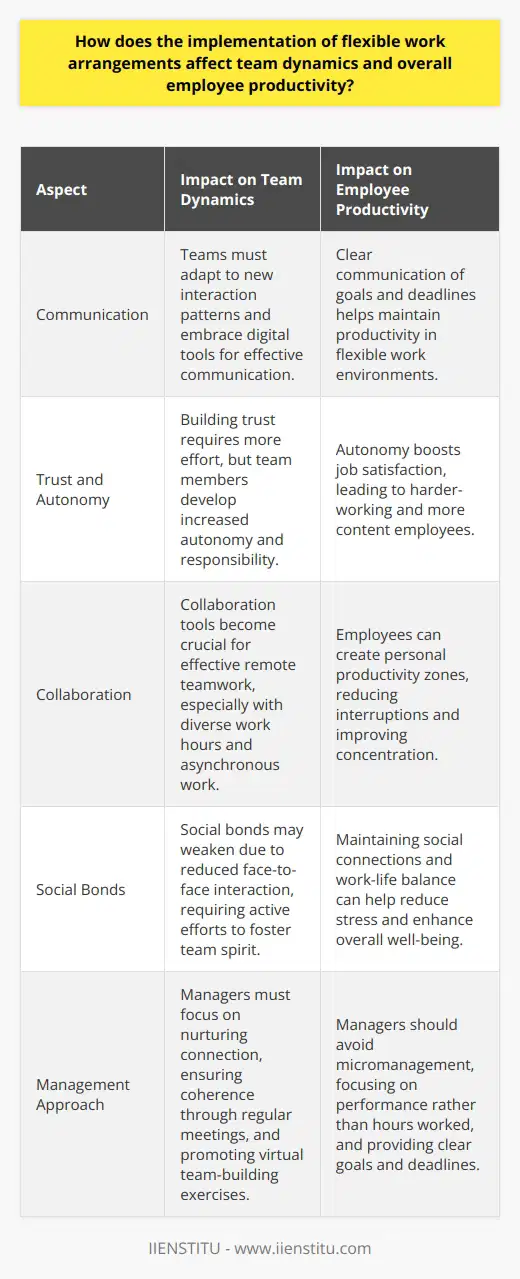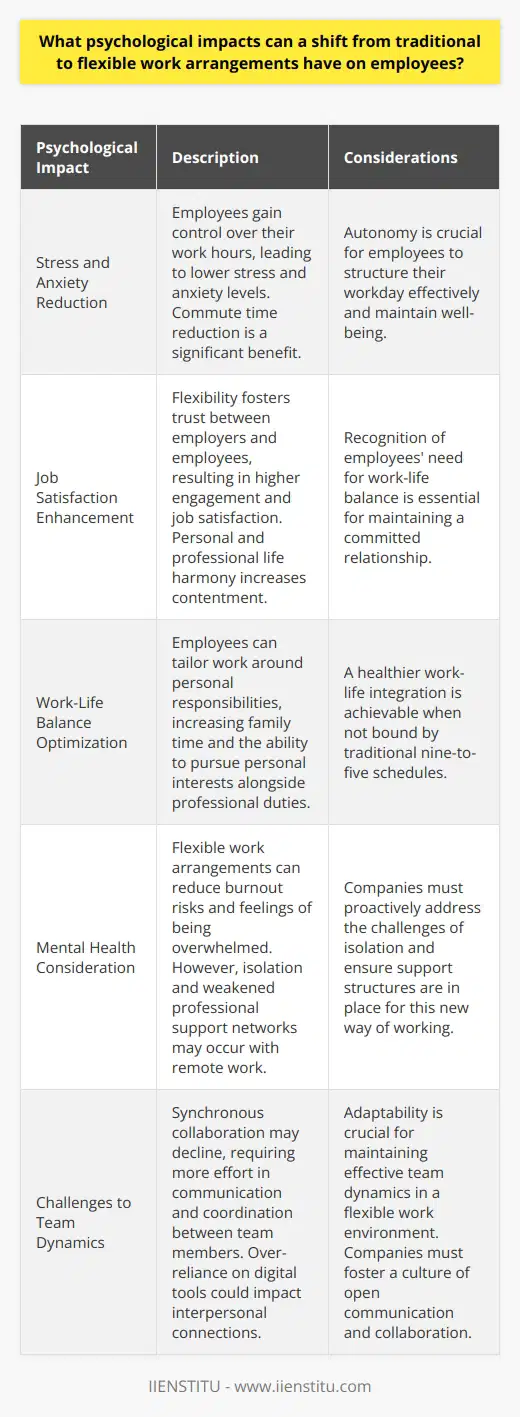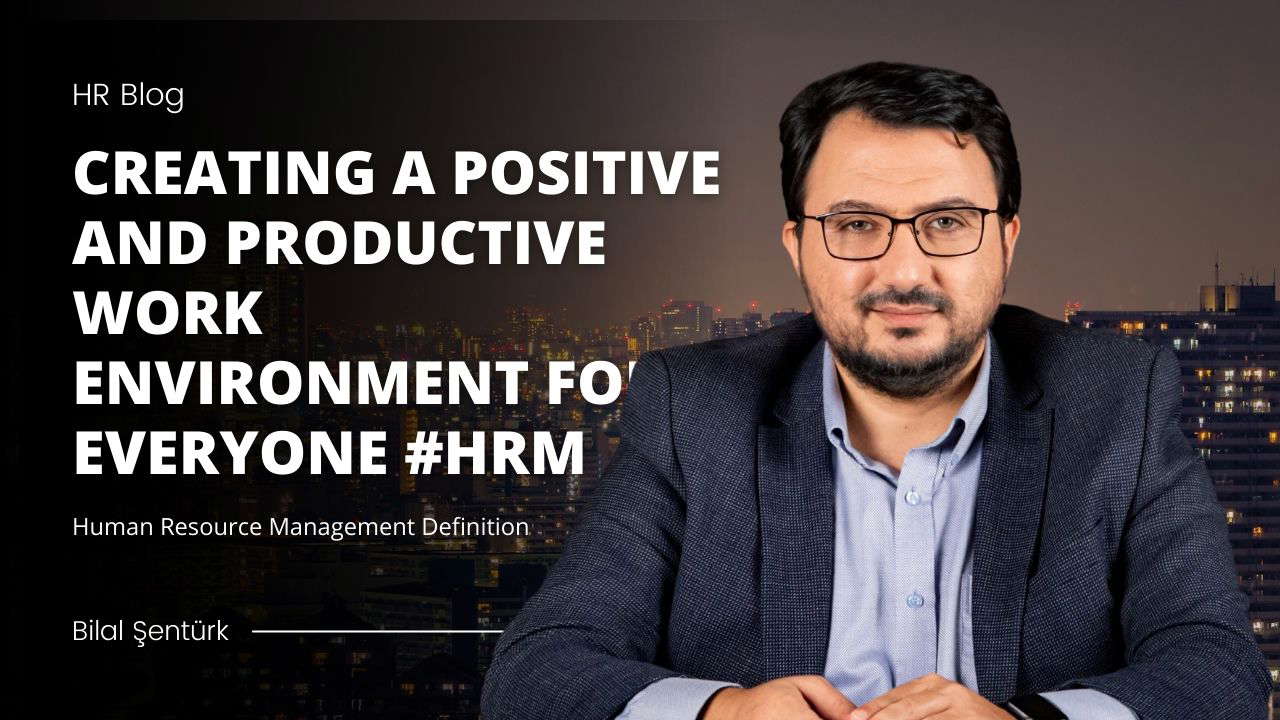
Flexible work arrangements have become an integral part of modern employment practices, offering a blend of flexibility and autonomy that caters to the diverse needs of today’s workforce. With the onset of technological advancements and shifting societal values, the demand for such arrangements has only increased, making it a cornerstone topic for those interested in human resources and organizational development.
In this blog, we will explore how flexible work arrangements impact employee engagement, delving into its various dimensions and implications. We aim to provide a comprehensive viewpoint, enriched with examples, that resonates with the expertise of leaders like Ellen Ernst Kossek in the field of workplace flexibility.
Understanding Flexible Work Arrangements
Flexible work arrangements are employment terms that allow for variability in work hours, location, and other factors that can contribute to an employee's work-life balance. These arrangements are tailored to support both the employee's personal responsibilities and the employer's business needs, creating a more harmonious working environment. Not only do they help employees manage their time more effectively, but they often lead to increased job satisfaction and loyalty towards the company.
Detailed explanation of Flexible Work Arrangements
Structured to accommodate personal life demands, such as childcare or eldercare, flexible work arrangements offer employees the chance to integrate their work responsibilities with their outside life more seamlessly. This may include options that vary daily start and end times or permit work to be completed from different locations. The aim is to create a work environment that recognizes the individual's circumstances and provides the support needed to maintain professional performance.
Types of Flexible Work Arrangements
There are multiple types of flexible work arrangements, with some of the most common including:
Flextime: Employees have the freedom to choose their working hours within a set range of time, promoting better control over their workday.
Compressed workweek: Employees work longer hours for a part of the week or pay period in exchange for shorter hours or additional days off.
Job sharing: Two or more people split the responsibilities of one full-time position, allowing for part-time commitments while fulfilling job duties.
Telecommuting: Employees work from a location outside the traditional office, often from home, using digital communication to stay connected.
Prevalence of flexible work arrangements in different regions
The acceptance and implementation of flexible work arrangements vary across the globe. European countries, for example, often lead in providing generous work-time flexibility options, while Asian countries may show a growing trend but with a more cautious uptake due to cultural norms around work. In North America, technology companies, in particular, have been pioneers in championing these arrangements.
The role of technology in flexible work arrangements
Modern technology stands as the backbone of today's flexible work arrangements. It has enabled virtual collaboration, remote access to workplaces, and the ability to stay connected with teams regardless of location, making online courses with certificates an integral part of learning and development for remote work. High-speed internet, cloud services, and mobile devices are a few tools that have made it possible for flexible work arrangements to thrive.
Advantages of Flexible Work Arrangements

The implementation of flexible work arrangements offers a myriad of benefits that can enhance both employee well-being and organizational success. By aligning work requirements with individual needs, companies can create a more engaged and productive workforce.
Benefits for employees
When employees are provided flexibility in their work schedules or locations, they experience several advantages:
Increased work-life balance: Flexible work allows employees to manage personal responsibilities alongside professional duties efficiently.
Reduction of commuting time and costs: Remote work opportunities can eliminate or significantly reduce commuting, saving time and financial resources.
Potential for increased productivity: Without the usual workplace distractions and with the possibility to work during hours they find most productive, many employees report better focus and output.
Benefits for employers
Employers also stand to gain from offering flexible work arrangements:
Greater employee motivation and retention: When workers feel their personal needs are respected, they are more likely to exhibit loyalty and engagement.
Reduced overhead costs: With more employees working remotely, there can be a decrease in the need for large office spaces and utility expenses.
Ability to hire talent from different geographical locations: Flexibility allows a company to tap into a broader talent pool, which is no longer restricted by proximity to a physical office location.
Supportive examples from successful companies implementing flexible work arrangements
Many prominent companies, such as Google, Basecamp, and Buffer, have shared success stories about embracing flexible work. By establishing trust and promoting autonomy, they have witnessed elevated levels of team morale and creativity. These examples serve as testimony to the notion that when implemented thoughtfully, flexible work arrangements can be a powerful tool to attract and retain high-caliber employees.
Challenges of Implementing Flexible Work Arrangements

Despite their advantages, flexible work arrangements come with their own set of challenges that need to be carefully managed to ensure they don't hinder employee or organizational performance.
Potential limitations for employees
Employees might face various challenges while working flexibly:
Out of sight, out of mind phenomenon: There's a risk of remote employees feeling isolated or disconnected from the main workflow and team camaraderie.
Difficulty in separating work from personal life: The blurring of boundaries between work and personal time can lead to burnout and stress if not managed effectively.
Potential limitations and concerns for employers
Employers may also encounter difficulties:
Issues related to trust and control: Supervisors may struggle with ceding direct oversight, leading to concerns about productivity and accountability.
Difficulties in coordination and communication: Ensuring clear and efficient communication across a dispersed workforce requires robust strategies and tools.
Tips to overcome these challenges
To mitigate these challenges, organizations can:
Establish clear policies and expectations regarding work outputs and availability.
Invest in proper technology and training to ensure smooth communication and workflow.
Encourage regular check-ins and virtual team-building activities to foster connection and collaboration among employees.
Illustrative case studies of difficulties faced and how they were resolved
Some organizations have shared case studies about their transition to flexible work. One such company struggled with maintaining culture and ensuring fair work distribution. By implementing a virtual coffee system where employees could have casual video chats, the company improved social connections. They also used project management software to transparently assign and track tasks, ensuring workload fairness and visibility.
Adapting to Flexible Work Arrangements in a Post-COVID World
The COVID-19 pandemic has undeniably altered the workplace landscape, thrusting the concept of flexible work arrangements into the limelight as never before. This shift is likely to have lasting implications for how work is structured globally.
The impact of COVID-19 on the surge of flexible work arrangements
Compelled by lockdowns and safety concerns, many businesses adapted to remote work setups rapidly. For some, this was an acceleration of existing policies, while for others, it was an entirely new foray. Consequently, there has been a rediscovery of the benefits and potential of flexible working models.
Long-term changes and adoption of flexible work arrangements
As the world moves past the immediate crisis, many companies are evaluating which practices to retain. Some have already announced permanent flexible work options, acknowledging their effectiveness and the preference many employees have shown for such arrangements.
Future predictions for flexible work in a post-pandemic scenario
Experts believe that hybrid models combining on-site and remote work will become standard in many industries. Companies that offer flexible options will likely be regarded as more attractive employers, and employees will increasingly expect flexibility as part of their employment package.
Steps to successful implementation and adaptation of flexible work arrangements post-pandemic
Businesses aiming to successfully implement flexible work arrangements post-pandemic will need to:
Revisit and potentially revise their policies to align with the new normal.
Continue investing in technologies that facilitate remote collaboration and project management.
Prioritize communication and company culture to ensure a cohesive workforce, irrespective of where work is being done.
Reflecting on the various aspects of flexible work arrangements, it is clear that they hold substantial promise for the evolution of the workplace. By considering both the benefits and the challenges, and approaching implementation with a strategic, people-focused mindset, organizations can harness these arrangements to foster a committed and content workforce.
Frequently Asked Questions
What key factors influence employee engagement in flexible work arrangements?
Understanding Employee Engagement
Employee engagement stems from numerous sources. These factors vary in flexible work arrangements. Such setups challenge traditional engagement methods.
Autonomy and Trust
Autonomy boosts engagement significantly. Employees control their work life balance. They appreciate this flexibility. Trust forms the foundation of this autonomy. Managers trust employees without constant oversight. Employees feel empowered. Empowerment facilitates engagement.
Clear Communication
Open channels support flexible work. Leaders must convey expectations precisely. Employees rely on clear instructions. Feedback loops further establish understanding. Regular check-ins prevent disconnects. Communication remains central to coordination.
Supportive Technology
Flexible work needs reliable tech. Easy-to-use tools enable collaboration. Connectivity issues disrupt productivity. Adequate support enhances the workflow. Affordability, accessibility, and training matter. Employees engage better with proper tools.
Work Environment
Home environments differ greatly. Distraction levels can vary. Supportive home offices boost focus. Employers can provide ergonomic advice. Some offer allowances for home office setup. Employee comfort contributes to engagement.
Recognition and Feedback
Appreciation motivates employees. Timely recognition sustains enthusiasm. Virtual acknowledgments have impact. Regular, constructive feedback guides employees. Public recognition in virtual meetings works. Positive reinforcement enhances morale.
Professional Development
Growth opportunities encourage engagement. Workers seek skill enhancements. Virtual training becomes essential. Employees value career progression. Companies offer online learning resources. They support further education and certifications. Development increases satisfaction.
Company Culture
Culture transcends physical spaces. Shared values and purpose bind teams. Virtual events maintain connections. Corporate social responsibility impresses employees. A strong culture retains talent. Commitment to culture influences engagement.
Work-Life Balance
Flexible arrangements affect work-life integration. Employees need to manage their time. Overwork diminishes engagement. Balance proves critical. Employers must respect off hours. Boundaries safeguard well-being. Well-being boosts engagement.
Health and Wellness
Physical and mental health affect performance. Wellness programs become more important. Employees crave support in remote setups. Employers offer virtual wellness resources. Health directly influences engagement levels.
Leadership Styles
Leaders must adapt. Flexible environments demand different approaches. Empathy and understanding play roles. Leaders exemplify adaptability. They coach rather than micromanage. Approachable leadership encourages engagement.
Conclusion
Numerous factors influence employee engagement in flexible work arrangements. Autonomy, communication, technology, and recognition rank high. Balance, wellness, and leadership also contribute. Companies that address these factors thrive. They enjoy engaged, productive workforces.

How does the implementation of flexible work arrangements affect team dynamics and overall employee productivity?
Flexible Work Arrangements: Impact on Team Dynamics and Productivity
Understanding Flexible Work Arrangements
Flexible work arrangements include varied start and end times. They also involve telecommuting and compressed workweeks. These options aim to boost balance between work and personal life.
Effects on Team Dynamics
Communication becomes key. Teams must adapt. Flexible schedules change interaction patterns. Members must therefore embrace digital tools. Regular updates keep connections strong. Scheduled meetings ensure coherence. Teams may face coordination challenges. Trust building requires more effort.
Members develop autonomy. They also show increased responsibility. Collaboration tools become crucial. They allow for effective remote teamwork. Diverse work hours lead to asynchronous work. Task interdependence requires careful planning. Teams may grow more resilient. They adapt to changing conditions successfully.
Empathy and understanding are essential. Team members respect individual needs. Social bonds may weaken. Face-to-face interaction declines. Managers must foster team spirit actively. Virtual team-building exercises can help here.
Impact on Employee Productivity
Flexible arrangements promote employee well-being. Workers experience less stress. They juggle life demands better. Autonomy boosts job satisfaction. Content employees tend to work harder.
Employees control work environments. They create personal productivity zones. Interruptions often decrease. Concentration improves. Work quality can increase.
However, risks exist. Procrastination may occur. Distractions at home can impede work. Self-discipline is critical. Clear goals and deadlines help here.
Organizations observe mixed results. Some report higher productivity. Others see little change. It depends on the context.
Monitoring productivity demands tact. Managers should avoid micromanagement. Performance should be the focus, not hours worked.
Conclusions
Flexible work arrangements transform teams and productivity. Communication, coordination, and trust become vital. Employee autonomy leads to higher job satisfaction. Productivity often improves but requires self-discipline. Managers should focus on nurturing connection and performance. Flexible work has complex implications. It demands attentiveness to maintain team coherence and output.

What psychological impacts can a shift from traditional to flexible work arrangements have on employees?
Shift to Flexible Work Arrangements
The transition from traditional to flexible work arrangements can significantly impact employees' psychological well-being. These impacts are multifaceted. They influence employees' stress levels, job satisfaction, work-life balance, and overall mental health.
Stress and Anxiety Reduction
Flexible work schedules often decrease stress. Employees gain control over their work hours. They can adapt their work to suit personal needs. Less time spent commuting is a substantial benefit. This often leads to lower anxiety levels. Employees feel less pressure from rigid schedules. They report higher levels of well-being. Autonomy is a key factor here. Employees value the freedom to structure their workday.
Job Satisfaction Enhancement
Job satisfaction often improves with flexibility. Workers report greater engagement. They feel their companies trust them. Recognition of their need for work-life balance increases. This trust fosters a more committed relationship. Happiness in the workplace rises. Individuals are more content when personal and professional lives harmonize.
Work-Life Balance Optimization
Work-life balance becomes more achievable. Employees tailor work around their lives. They attend to personal responsibilities more easily. Family time increases. Personal interests can coexist with professional duties. The traditional nine-to-five schedule does not bind them. The result is often a healthier work-life integration.
Mental Health Consideration
The mental health implications are significant. Flexibility can reduce burnout risks. Employees report fewer feelings of being overwhelmed. However, it is important to consider potential downsides. Isolation can occur with remote work. Professional support networks may weaken. Companies must address these challenges proactively.
Challenges to Team Dynamics
Team dynamics can change. Synchronous collaboration may decline. Communication demands more effort. Coordination between team members requires adaptability. Over-reliance on digital communication tools could reduce interpersonal connections.
Overall, flexible work arrangements carry substantial psychological benefits for employees. These benefits include reduced stress, improved job satisfaction, better work-life balance, and potentially enhanced mental health. Companies must remain vigilant, however, to mitigate any negative impacts on team cohesion and individual isolation. They must ensure support structures are in place for this new way of working to succeed.



